Chlorosis of grapes: causes of yellowing of leaves and remedies for their treatment (iron vitriol, iron chelate)
Your grape leaves turned yellow, so to speak, they began to "chlorose", so you decided to look for information about this problem, didn't you?
Next, you will find out what chlorosis of grapes is, the reasons for its appearance (yellowing of the leaves), how it is dangerous for your vineyard, and most importantly - how to treat it (how to treat it, what else can be done).
Important! This article will focus on grape chlorosis caused by excess lime and lack of iron.
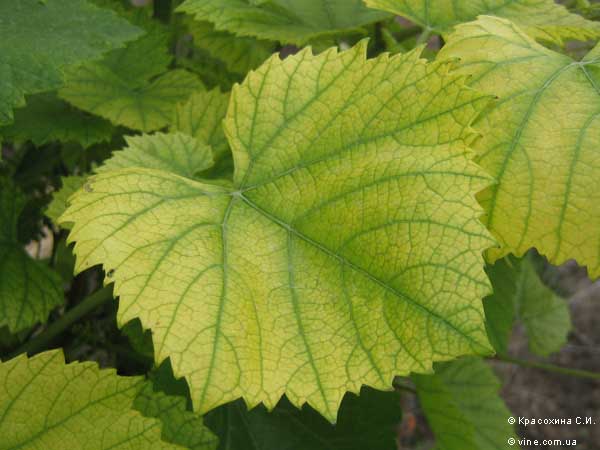
Content
Chlorosis of grape leaves: description (signs), causes
Chlorosis is usually called virtually any yellowing of leaves, although reasons this phenomenon maybe several and it can look (manifest) in completely different ways.
Chlorosis of leaves can be caused by lack of nitrogen (the whole leaf turns yellow evenly), potassium (the edges / tips of the leaves turn yellow and dry), magnesium.
By the way! The site already has an article about the reasons for the yellowing of the leaves of seedlings (vegetable, flower).
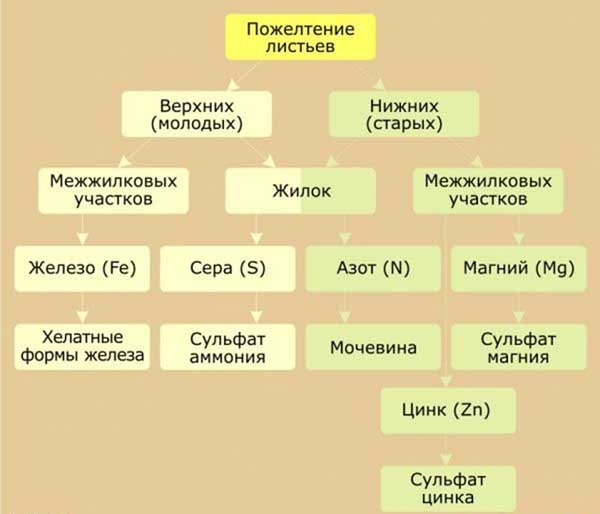
However! In most cases, the cause of chlorosis in grapes is precisely the lack of iron against the background of excess lime (calcareous chlorosis).
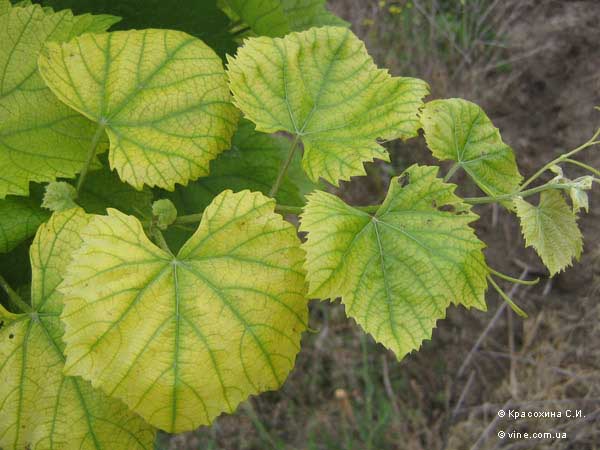
Thus, below we will consider precisely calcareous chlorosis of grapeswhich is called lack of ironassociated with excess lime in the soil (the soil is alkaline).
Advice! The site has a detailed article about how to find out the acidity of the soil on the site.
So, with lime chlorosis, grape leaves turn yellow (turn yellow), wherein veins remain green (they also say interveinal chlorosis of plant tissues, i.e. the space between the veins turns yellow, not themselves), while first, it is the upper (young) leaves that turn yellow.
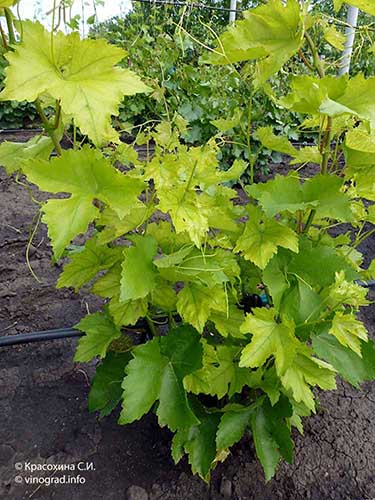
- Why do the leaves turn yellow?
The fact is that with a lack of iron plant unable to form chlorophyll, the reduction of which makes the leaves turn yellow, and then completely discolor.
And as we have already found out, chlorosis of grapes, as a rule, occurs with an alkaline reaction of the soil (excess lime), respectively, here is the main reason for the yellowing of the leaves.
- How is the alkaline reaction of the soil (excess lime) and iron deficiency related?
If the soil is too alkaline (there is an excess of lime in it), then iron will simply blocked (connected) and be in an insoluble form, in other words, will be not available for plant.
Even if your soil contains iron (and, as a rule, it is, as a rule, it is almost always in excess), when the reaction of the soil is alkaline (with an excess of lime in it), iron will still not be absorbed by the plant.
Most favorable conditions for the emergence and development of chlorosis grapes areprolonged rains, contributing to excessive moisture in the soil (especially heavy clay).
- So what is the danger of chlorosis for grapes?
Under favorable weather conditions (moderately dry and warm) fungal diseases are almost not manifested, the berries are well tied and ripen, the shoots ripen.
It's another matter if unfavorable weather (frequent rains, cool): the leaves turn yellow (chlorosis), sometimes they even fall off prematurely (not having time to fulfill their function), the ovaries may crumble (the yield decreases), the young growth weakens and does not ripen (it may freeze in winter).
In other words, chlorosis is dangerous both for young bushes and newly planted seedlings, and for fruit-bearing bushes.
We remind you! High humidity is also a favorable environment for the development of various fungal diseases (mildew, gray rot, anthracnose, and here oidiumon the contrary, it likes dry weather).
How to treat chlorosis of grape leaves: feeding with iron vitriol and iron chelate
As a rule, for the treatment of chlorosis of grapes in the old fashioned use inkstone (this is the oldest and most proven, but not very effective method).
Reminds! inkstone - it is primarily an antiseptic (fungicidal) agent, and secondly, a source of iron.
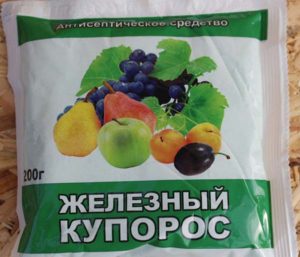
- So, you need to prepare a 1-4% solution of ferrous sulfate (100-400 grams of vitriol per 10 liters of water).
1% - in general, 2-4% - in the case of severe chlorosis of the entire bush.
- Then add an additional 20-40 grams of citric acid (for better absorption of iron, converting it into a more easily digestible form).
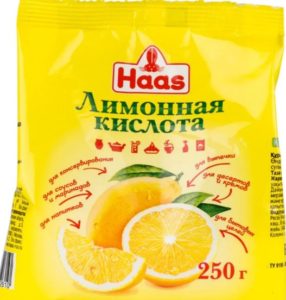
- Under one bush depending on its age (size) and the degree of iron deficiency (how much the leaves chlorosis), pour out from 10 to 40 liters of solution (for an adult and abundantly fruiting bush - at least 30 liters, for a very young and not fruiting seedling, 10 will be enough).
However, where more effective to do not root feeding, but foliar feeding (spraying on the leaves).
For this you better take advantage of iron chelate, for example, a special drug "Ferovit» .
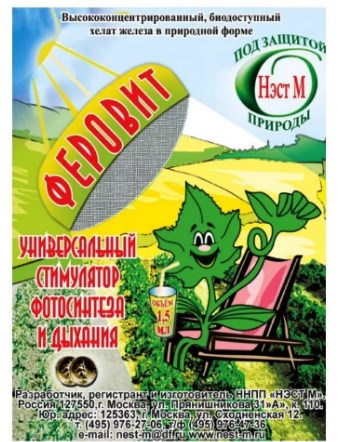
On sale you can find simply microfertilizer "Chelate Iron".
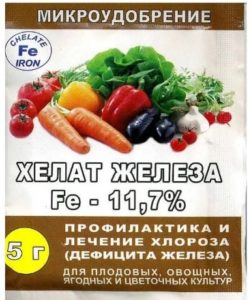
You need to carry out at least 3-4 such treatments on the sheet with this preparation with an interval of 5-7 days. One treatment, as a rule, will have no effect.
In this case, it is optimal to conduct complex fight against chlorosis, namely:
- water under the root with a solution of ferrous sulfate (1 time every week);
- do foliar top dressing on the sheet with iron chelate (Ferovit) every 5-7 days.
As a rule, chlorosis treatment takes at least 3-4 weeks, i.e. on average lasts 1 month or more.
In general, always it is better to prevent chlorosis than fight it later, therefore, every spring you can do preventive foliar dressing of grapes with iron, more precisely, with iron chelate (for example, with the drug "Ferovit").
However! You must understand that these measures (the use of ferrous sulfate and even "Ferovit") are only a temporary solution to the problem (treatment for the season). For a more lasting effect, you will need to implement special preventive agrotechnical measures, which we will talk about further (in the next paragraph).
Prevention and prevention measures of chlorosis of grapes
Advice! If you doubt that chlorosis of grape leaves is caused precisely by a lack of iron (excess lime in the soil), then be sure find out and measure the acidity of your soil.
Selection of sustainable rootstock and scion.
If your soil is alkaline (pH above 7-8), rich in lime, then you need to initially plant as much lime-resistant rootstocks (at least do not plant very susceptible ones).
Note!
Despite the fact that it is the root system of the plant that is sensitive to lime, it has been proven that on alkaline soils it is necessary to use not only sustainable rootstocks, but also resistant grafts... The fact is that even if the stock was initially stable, then grafting a scion susceptible to lime on it, most likely, such a plant will develop extremely poorly and constantly chlorose, which ultimately will lead to the death of the bush.
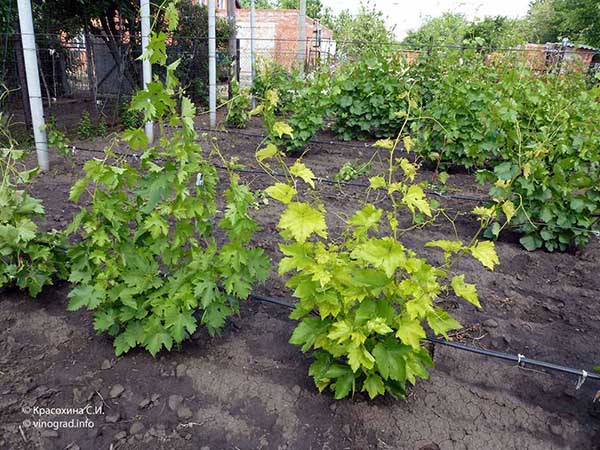
- The most sensitive rootstock is Riparia, the less sensitive (more resistant) is Rupestris, the most resistant is Berlandieri.
Also fairly stable stocks are Ferkal (Berlandieri x Riparia) and 41B (Shasla x Berlandieri).
- The most sensitive European variety is Sylvaner, Riesling is considered less resistant, Traminer, Pinot noir, Pinot gris, Chasselas, and relatively persistent - Trollinger, Portugieser, Limberger, Müller-Thurgau, Pinot meunier, Elbling,Saint Laurent and Muscatel.
Improving soil conditions
If your soil is light soil (sandy, loamy, pebble), then, most likely, you will not have any special problems with chlorosis. At the very least, it will be much easier to respond to treatment.
If your soil is dense and heavy (clayey), moisture stagnates strongly, then you will definitely have to take certain measures.
Heavy soil, excessive dampness (moisture stagnation) contribute to chlorosis.
- So, how can you improve the soil conditions in your vineyard, namely the air and water permeability of the soil?
Firstly, if the ground after heavy rains is strongly compacted, then you need to be sure to carry out loosening row spacing (to improve aeration - saturation of the roots with oxygen).
Interesting! First of all, the leaves begin to chlorose due to the fact that the roots lack oxygen, and then from the lack of iron.
So that the water does not stagnate, you can and should make a good drainage system using pipes, crushed stone or slag.
Advice! The site already has material about how to properly water grapes, including described the ways of organizing irrigation (including by creating drainage wells).
To improve the structure (so that it becomes looser, moisture and air permeable), the soil can be applied rotted organic matter - humus, compost, and peat.
Wherein fresh manure cannot be usedsinceduring its decomposition, an abundant release of carbon dioxide occurs, which contributes to the dissolution of lime, in other words, only enhances chlorosis.
And also acidify the soil (so that iron is better absorbed in it) you can by introducing fresh sawdust (pine)... Moreover, they must be introduced into the soil, and not mulched.
You can cover, so to speak, mulch the soil surface with a 10-15 cm layer of slag, cut grass.
Thanks to mulching, you do not need to control weeds and additional loosening.
Alternatively, if you have frequent and heavy rainfall, and the soil is heavy, then you can soil the soil and thereby prevent chlorosis, for example, by sowing perennial grasses and mixtures (consisting of white clover, meadow fescue and meadow bluegrass, bent grass (shoot-forming), etc.) or deep-rooted crops, for example, alfalfa.
Soil sodding is carried out to improve its structure, protect it from overheating, dry out and wash away, improve air and moisture exchange.
Important! Remember to mow the grass regularly to create a mulch layer.
Correct feeding
If your soil is alkaline, then, accordingly, you need to apply as much as possible exactly physiologically acidic fertilizers, which include the following:
- urea, ammonium nitrate and especially ammonium sulfate (nitrogen fertilizers);
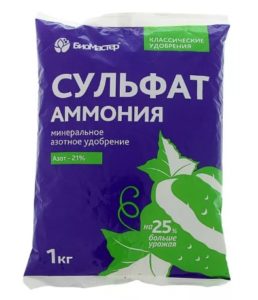
- potassium sulfate (potash fertilizer);
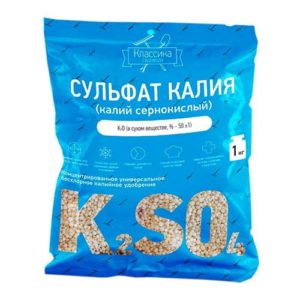
And here wood ash (if used as a potash fertilizer), on the contrary, will alkalize the soil.
Advice! In order not to provoke chlorosis, you can carry out foliar dressing with an ash extract by sheet.
However! If your soil is acidic, then you can use wood ash (most likely, you have a different cause of chlorosis).
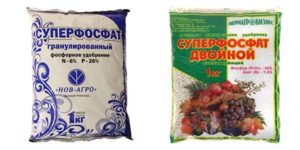
Of course, you should also do preventive foliar feeding with iron in the spring (before and after flowering), spraying on the leaves with an iron chelate solution (Ferovit).
Good luck with your chlorosis treatment! And let the leaves of your grapes turn yellow only in the fall, when it is laid down by nature itself.

